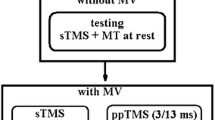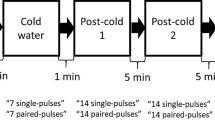Abstract
Modulation of ongoing electromyographic (EMG) activity in the small hand muscles can be induced by electrical stimulation of the digital nerves or by stimulation of the skin of the fingers. Several groups have attempted to establish a role for the motor cortex in the generation of the facilitatory component of the cutaneomotor reflex. Our aim was to establish if the facilitatory component of the reflex could be diminished by a procedure known to inhibit the motor cortex, namely, subthreshold transcranial magnetic stimulation. During sustained small contractions of the first dorsal interosseus muscle transcranial magnetic stimuli (TMS), which were subthreshold for the generation of a motor evoked potential, were delivered via a figure-of-eight coil. Inhibition of ongoing EMG was observed in all subjects. In two separate series of trials, TMS was timed so that the resultant inhibition occurred coincident with either the short or long latency stretch reflex or with the initial or later part of the facilitatory component of the cutaneomotor reflex. The short latency stretch reflex is known to involve a largely monosynaptic loop via the spinal cord, whereas the long latency response involves a transcortical loop. The long latency response was reduced in size following subthreshold TMS, whereas the short latency response was unchanged. This provides evidence of the effectiveness of subthreshold TMS in inhibiting a transcortical reflex. When the TMS was timed so that the inhibition occurred coincident with the facilitatory component of the cutaneomotor response, neither the early nor later changes were inhibited. Thus, the pathway of the long-latency cutaneomotor reflex is not similar to the transcortical pathway of the stretch reflex. Either the response does not travel via the cortex or it involves different cortical neurones.




Similar content being viewed by others
References
Baker SN, Lemon RN (1995) Non-linear summation of responses in averages of rectified EMG. J Neurosci Methods 59:175–181
Bisley JW, Goodwin AW, Wheat HE (2000) Slowly adapting type I afferents from the sides and end of the finger respond to stimuli on the centre of the fingerpad. J Neurophysiol 84:57–64
Caccia MR, McComas AJ, Upton ARM, Blogg T (1973) Cutaneous reflexes in small muscles of the hand. J Neurol Neurosurg Psychiatry 36:960–977
Cole KJ, Abbs JH (1988) Grip force adjustments evoked by load force perturbations of a grasped object. J Neurophysiol 60:1513–1521
Davey NJ, Romaiguere P, Maskill DW, Ellaway PH (1992) Inhibition of voluntary contraction by transcranial magnetic stimulation of the brain subthreshold for excitation in man. J Physiol 446:447P
Davey NJ, Romaiguere P, Maskill DW, Ellaway PH (1994) Suppression of voluntary motor activity revealed using transcranial magnetic stimulation of the motor cortex in man. J Physiol 477:223–235
Day BL, Riescher H, Struppler A, Rothwell JC, Marsden CD (1991) Changes in the response to magnetic and electrical stimulation of the motor cortex following muscle stretch in man. J Physiol 433:41–57
Deuschl G, Schenck E, Lucking CH (1985) Long latency responses in human thenar muscles mediated by fast conducting muscle and cutaneous afferents. Neurosci Lett 55:361–366
Deuschl G, Michels R, Berardelli A, Schenck E, Inghilleri M, Lucking CH (1991) Effects of electric and magnetic transcranial stimulation on long latency reflexes. Exp Brain Res 83:403–410
Di Lazzaro V, Restuccia D, Oliviero A, Profice P, Ferrara L, Insola A, Mazzone P, Tonali P, Rothwell JC (1998) Magnetic transcranial stimulation at intensities below active motor threshold activates intracortical inhibitory circuits. Exp Brain Res 119:265–268
Evans AL, Harrison LM, Stephens JA (1989) Task-dependent changes in cutaneous reflexes recorded from various muscles controlling finger movement in man. J Physiol 418:1–12
Evans AL, Harrison LM, Stephens JA (1990) Maturation of the cutaneomuscular reflex recorded from the first dorsal interosseus muscle in man. J Physiol 428:425–440
Garnett R, Stephens JA (1980) The reflex responses of single motor units in human first dorsal interosseus muscle following cutaneous afferent stimulation. J Physiol 303:351–364
Garnett R, Stephens JA, Usherwood TP (1976) Changes in the probability of firing of human motor units following cutaneous stimulation. J Physiol 260:69P–70P
Jenner JR, Stephens JA (1982) Cutaneous reflex responses and their central nervous pathways studied in man. J Physiol 333:405–419
Johansson RS (1978) Tactile sensibility in the human hand: receptive field characteristics of mechanoreceptive units in the glabrous skin area. J Physiol 281:101–125
Johansson RS, Vallbo AB (1983) Tactile sensory coding in the glabrous skin of the human hand. Trends Neurosci 6:27–32
Johansson RS, Westling G (1984) Roles of glabrous skin receptors and sensorimotor memory in the automatic control of precision grip when lifting rougher or more slippery objects. Exp Brain Res 56:550–564
Johansson RS, Westling G (1987) Signals in tactile afferents from the fingers eliciting adaptive motor responses during precision grip. Exp Brain Res 66:141–154
Johansson RS, Landstrom U, Lundstrom R (1982) Sensitivity to edges of mechanoreceptive afferent units innervating the glabrous skin of the human hand. Brain Res 244:27–35
Johansson RS, Lemon RN, Westling G (1994) Time-varying enhancement of human cortical excitability mediated by cutaneous inputs during precision grip. J Physiol 481:761–775
Kujirai T, Caramia MD, Rothwell JC, Day BL, Thompson PD, Ferbert A, Wroe S, Asselman P, Marsden CD (1993) Corticocortical inhibition in human motor cortex. J Physiol 471:501–519
Macefield VG, Rothwell JC, Day BL (1996) The contribution of transcortical pathways to long-latency stretch and tactile reflexes in human hand muscles. Exp Brain Res 108:147–154
Maertens de Noordhout A, Rothwell JC, Day BL, Dressler D, Nakashima K, Thompson PD, Marsden CD (1992) Effect of digital nerve stimulation on responses to electrical or magnetic stimulation of the human brain. J Physiol 447:535–548
Ohki Y, Suzuli T, Ugawa Y, Uesaka Y, Sakai K, Kanazawa I (1994) Excitation of the motor cortex associated with the E2 phase of cutaneous reflexes in man. Brain Res 633:343–347
Palmer E, Ashby P (1992a) Evidence that a long latency stretch reflexes in humans is transcortical. J Physiol 449:429–440
Palmer E, Ashby P (1992b) The transcortical nature of the late reflex responses in human small hand muscle to digital nerve stimulation. Exp Brain Res 91:320–326
Petersen NT, Butler JE, Marchand-Pauvert V, Fisher R, Ledebt A, Pyndt HS, Hansen NL, Nielsen J (2001) Suppression of EMG activity by transcranial magnetic stimulation in human subjects during walking. J Physiol 537:651–656
Phillips JR, Johnson KO (1981) Tactile spatial resolution. II. Neural representation of bars, edges and gratings in monkey primary afferents. J Neurophysiol 46:1192–1203
Ridding MC, Rothwell JC (1999) Afferent input and cortical organisation: a study with magnetic stimulation. Exp Brain Res 126:536–544
Stephens JA, Usherwood TP (1976) Changes in the probability of firing of human motor units following cutaneous nerve stimulation. J Physiol 258:49P–51P
Taylor JL, Fogel W, Day BL, Rothwell JC (1995) Ipsilateral cortical stimulation inhibited the long-latency response to stretch in the long finger flexors in humans. J Physiol 488:821–831
Vierck CJ (1979) Comparisons of punctate, edge and surface stimulation of peripheral, slowly-adapting, cutaneous, afferent units of cats. Brain Res 175:155–159
Author information
Authors and Affiliations
Corresponding author
Rights and permissions
About this article
Cite this article
Stuart, M., Taylor, J.L. Subthreshold transcranial magnetic stimulation during the long latency component of the cutaneomotor reflex. Exp Brain Res 170, 285–294 (2006). https://doi.org/10.1007/s00221-005-0222-8
Received:
Accepted:
Published:
Issue Date:
DOI: https://doi.org/10.1007/s00221-005-0222-8




